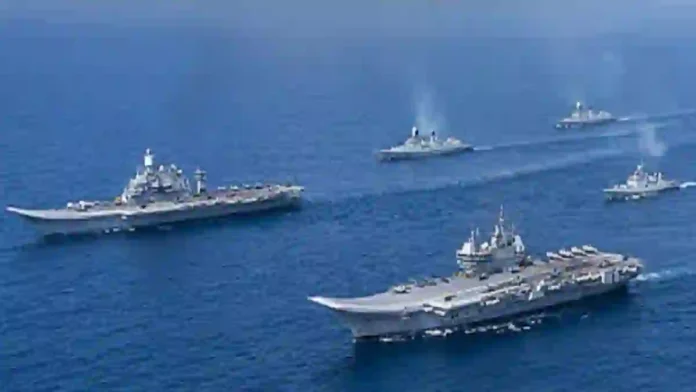India’s carrier modernisation is at a crossroads, with its ambitions to field a next-generation CATOBAR (Catapult Assisted Take-Off But Arrested Recovery) carrier delayed by external technology bottlenecks. The Indian Navy currently operates two STOBAR (Short Take-Off But Arrested Recovery) carriers—INS Vikramaditya and INS Vikrant—both limited by ski-jump launches that restrict fighter aircraft to lighter fuel and weapons loads. This curtails endurance and strike flexibility, undermining India’s power projection across the Indian Ocean and beyond.
The proposed INS Vishal, intended as a 65,000-ton super-carrier, symbolised the leap toward advanced naval aviation capability. Designed to incorporate U.S.-developed EMALS (Electromagnetic Aircraft Launch System) and possibly nuclear propulsion, the carrier was projected as a qualitative rival to Chinese PLAN carriers expanding into the Indo-Pacific. However, despite frameworks under the 2015 Defence Technology and Trade Initiative (DTTI), EMALS technology transfers remain uncertain. U.S. export regulations, Congressional oversight, and concerns over cost and technical maturity have significantly slowed progress.
Read- L&T Forms Strategic Partnership With BEL For India’s AMCA 5th-Generation Fighter Aircraft Program
India’s challenge lies not only in negotiating access to foreign technologies but also in the rising costs and delays. EMALS integration, already proving complex for the U.S. Navy’s Gerald R. Ford-class carriers, raises operational and maintenance concerns. These obstacles mean India’s timelines for INS Vishal have slid well beyond 2030, weakening its ability to keep pace with regional naval expansions, particularly China’s rapid commissioning of CATOBAR-ready carriers.
In response, self-reliance initiatives are gaining momentum. DRDO has ramped up research into indigenous EMALS prototypes, drawing on advances in high-power electronics, superconducting materials, and pulsed power systems. Parallel efforts in electric drive propulsion and integrated power systems align with broader Atmanirbhar Bharat goals, though these remain in early experimental phases. This transition, while technologically arduous, could shield India from dependency on external partners while solidifying domestic manufacturing ecosystems.
On the aviation front, New Delhi has approved the acquisition of 26 Rafale-M carrier fighters in a deal worth around $8 billion. These aircraft provide immediate operational reinforcement for Vikrant and Vikramaditya while remaining future-compatible with CATOBAR vessels. Pairing Rafale-M with potential naval AMCA variants offers long-term fleet standardisation, bridging gaps until Vishal materialises.
Read- India Successfully Tests Agni-Prime Missile From Rail-Based Mobile Launcher
Read- Russia Will Complete Deliveries of S-400 Missile Systems To India In 2026
Alternative partnerships are also under study. France has signalled willingness to collaborate on nuclear propulsion reactors, similar to those powering the Charles de Gaulle, while UK firms are exploring contributions to electric drive propulsion systems. Such diversification of partners reflects India’s strategy to reduce over reliance on any single supplier, mitigating risks from geopolitics or export restrictions.
The strategic debate within India’s Navy circles, however, is intensifying. Without timely CATOBAR capabilities, the service risks committing scarce resources to an asset vulnerable to obsolescence.
This strengthens arguments for prioritising submarine expansion—both nuclear and conventional—which offers assured deterrence, sea denial, and survivability against evolving threats. Given China’s formidable and growing undersea fleet, submarines arguably provide more immediate operational advantages than delayed mega-carriers.
India’s carrier plan highlights a broader dilemma: balancing ambition with pragmatism. While super carriers remain vital for blue-water dominance and sea-lane security, their effectiveness depends on uncompromised technology, reliable aircraft operations, and assured financial commitment. Unless decisive progress is secured on EMALS transfers, indigenous power solutions, or strategic partnerships, INS Vishal risks being repeatedly delayed, weakening India’s maritime deterrence posture.
IDN (With Agency Inputs)
Agencies




